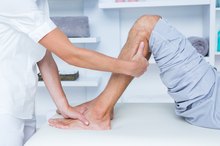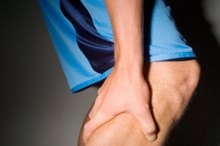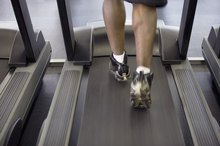Blood Clot Exercise Precautions
Blood clots typically occur in the large veins of the legs but also can form in the arms and upper body. Also called deep vein thrombosis, or DVT, blood clots prevent normal blood flow and can cause swelling and pain at the location of the clot. Occasionally a blood clot can travel to other parts of the body and cause interruption of blood flow to the brain, heart or lungs. The affects of a blood clot can be fatal. Therefore, it is best to take measures to prevent them from forming.
If you are experiencing serious medical symptoms, seek emergency treatment immediately.
Risks
A number of factors can place you at risk for blood clot formation. Blood clots can occur at any age but occur most often in people over age 60.
Signs and Symptoms
Blood Clots & Flat Red Spots on Legs
Learn More
The symptoms of a blood clot include pain, tenderness and redness at the site of the clot. The area may by swollen and warm to touch. A physician will diagnose a blood clot considering factors such as family history, medications, recent activities and physical examination of the site. Blood tests, an ultrasound or an X-ray also may be used to confirm a blood clot.
- The symptoms of a blood clot include pain, tenderness and redness at the site of the clot.
- A physician will diagnose a blood clot considering factors such as family history, medications, recent activities and physical examination of the site.
Prevention
Regular exercise, maintaining a healthy weight and quitting smoking can help prevent blood clot formation, according to the Centers for Disease Control and Prevention 2. Additionally, drinking plenty of water, taking walking breaks and performing sitting exercises such as neck, shoulder and ankle rolls enhance blood flow and reduce the likelihood of clot formation. Those who have a history of blood clot formation or are at high risk may need to take blood thinners or wear pressure stockings prescribed by their physician.
Precautions
What Are the Symptoms of a Blood Clot in Your Ankle?
Learn More
According to the Inate website, movement soon after blood clot treatment helps relieve symptoms and improves recovery time. Exercise should be supervised and can include normal walking for short distances. The level of exercise depends on the symptoms exhibited at the time the blood clot was identified and level of treatment initiated. For example, if you are experiencing difficulty breathing or cannot take blood thinners, exercise may be contraindicated.
- According to the Inate website, movement soon after blood clot treatment helps relieve symptoms and improves recovery time.
- For example, if you are experiencing difficulty breathing or cannot take blood thinners, exercise may be contraindicated.
Related Articles
References
- Deep Venous Thrombosis: February 2011
- Centers for Disease Control and Prevention; Are You at Risk For Deep Vein Thrombosis?; March 2011
- American Society of Hematology. Blood Clots.
- Litvinov RI, Weisel JW. What Is the Biological and Clinical Relevance of Fibrin?. Semin Thromb Hemost. 2016;42(4):333-43. doi:10.1055/s-0036-1571342
- American Heart Association. Understand Your Risk for Excessive Blood Clotting.
- Adivitiya, Khasa YP. The evolution of recombinant thrombolytics: Current status and future directions. Bioengineered. 2017;8(4):331-358. doi:10.1080/21655979.2016.1229718
- Fields JM, Davis J, Girson L, et al. Transthoracic Echocardiography For Diagnosing Pulmonary Embolism: A Systematic Review And Meta-Analysis. J Am Soc Echocardiogr 2017; 30:714. doi:10.1016/j.echo.2017.03.004
- Gibson NS, Schellong SM, Kheir DY, et al. Safety And Sensitivity Of Two Ultrasound Strategies In Patients With Clinically Suspected Deep Venous Thrombosis: A Prospective Management Study. J Thromb Haemost 2009; 7:2035. doi:10.1111/j.1538-7836.2009.03635.x
- National Blood Clot Alliance. Signs and Symptoms of Blood Clots.
- Weitz JI, Fredenburgh JC, Eikelboom JW. A Test In Context: D-Dimer. J Am Coll Cardiol 2017; 70:2411. doi:10.1016/j.jacc.2017.09.024
Writer Bio
Eurica Manning is a registered nurse who began writing professionally in 2007 with the North Carolina Department of Health and Human Services. She specializes in topics related to health and wellness. Manning holds a Master of Science in nurse education.








